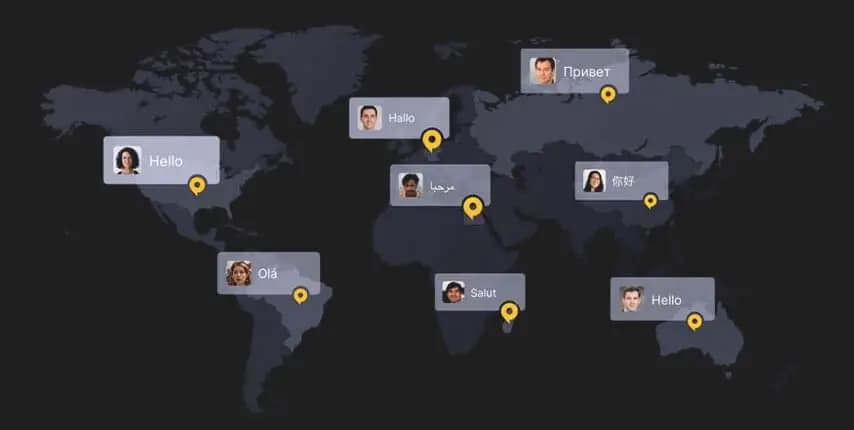SAP Software Localization
SAP software systems empower a wide range of companies worldwide, the number of their customers is nearly 440,000 customers in 180+ countries, 200 million users worldwide and 22,200 SAP partner companies in 140 countries.
But what is the reason behind all the popularity that SAP has achieved over the last 50 years?
Let’s dig into SAP systems world and SAP Software Localizationto process to see how big it is and how localization and translation of your SAP system could help in your business growth.
What Is SAP and What Is SAP Software Localization?
SAP is an acronym for Systems, Applications, and Products in data processing, is a renowned global multinational company dedicated to developing enterprise software that effectively manages customer relations and streamlines business processes.
Saudisoft is a trusted translation and localization services partner for SAP. We provide them with many language services encompassing various crucial aspects such as translation, testing, and desktop publishing (DTP). We have been collaborating with SAP systems to ensure their software and content are seamlessly adapted for Arabic-speaking markets.
SAP software translation is delivered to customers and partners in different ways to help in achieving the business’s goals
4 Values That Every SAP Software Translation Will Bring to Your Business
Translating your SAP system to the language of your employees will bring them peace of mind and ease in their day managing work for these values that surely will happen:
1. Translation will enhance your global reach: SAP software translation services enable businesses to expand worldwide when providing localized software solutions that support multiple languages and currencies leading to expansion to new markets and catering to diverse customer needs.
2. Compliance with local laws and Risk Management: SAP software localization ensures compliance with local laws and regulations. By localizing to the targeted country’s legal requirements, businesses can minimize risks and confidently operate.
3. Streamlined Operations: SAP software localization services help streamline business processes because of the integration of local tax calculation leading to more efficiency and productivity across global operations.
4. Continuous Support: SAP Globalization Services provide support and updates to ensure that the localized software remains up-to-date helping businesses to stay competitive and leverage the latest innovations in their target markets.
SAP Software Translation for Different Languages
SAP software translation includes translating the user interface, documentation, and other content within SAP into the required languages to cater to diverse global markets. Offering a localized SAP system to the end users enables people from various regions to effectively interact with it, leading to enhancement in the user experience, facilitating seamless communication, and promoting a global adoption of your system.
SAP software can be translated into hundreds of languages to cater to users from different cultures worldwide and meet your target audience’s specific needs. Without SAP software translation, many aspects such as information architecture, output format, tone of voice, and word choices won’t be covered.
While translating the source text, ensure that it aligns with your language, culture, and the nature of the products being translated. If there are specific linguistic requirements for your language, incorporate them into your translation.
Why Is SAP Software Translation Different Than Other Types of Translation?
1. Technical Complexity: SAP software contains technical and specialized terminologies related to business processes, software functionality and industry concepts. Translating these technical terms accurately requires in-depth knowledge and understanding of both the software and the target language.
2. User Experience: SAP software translation goes beyond linguistics. It aims to provide a seamless and intuitive user experience in the target audience’s language. Translators must ensure that the translated software maintains functionality, layout, and usability while considering language-specific conventions and user expectations.
3. Collaborative Process: SAP software translation often involves collaboration between translators, technical experts, and software developers. Translators work closely with software teams to understand the context, provide feedback, and ensure seamless integration of translated content within the software interface.
4. Ongoing Updates: SAP software is regularly updated with new features, enhancements, and bug fixes. Translators need to stay up to date with these changes and provide timely translations for new content, ensuring that the software remains consistently translated across all updates.
5. Translation Unit: The SAP software translation realm. Unlike word count, lines are commonly used as the unit of measurement, which affects productivity measurements.
6. The Source Type: The source type in SAP software translation is not determined by the file format, such as RTF or doc. Instead, it is defined by the line type, which can be short or long. Short lines typically appear in the user interface (UI) content of SAP software, while long texts are found in SAP system-related content like end-user documentation, online help, and business blueprints.
The Process of SAP Software Translation Under Microscope
It is divided into two phases,1. Short Lines Translation:Short lines in SAP systems are translated using a tool called the “Short Text Editor.” This tool allows translators to efficiently handle the translation of shorter UI text segments within the SAP software interface.
To support the translation process in this phase, SAP systems utilize the “Proposal Pool” that serves as a repository of previously translated and validated short text segments.2. Long Lines Translation:
When it comes to long lines of SAP software translation, the SDL Trados Studio tool is commonly used. This robust translation software, coupled with the assistance of Translation Memories (TMs), enables translators to effectively handle the translation of longer text segments within the SAP system.
Is There Any Difference Between Translating Normal SAP system and SAP Fiori?
SAP Fiori focuses on providing a modern, intuitive, and role-based user interface for SAP software applications across different devices. It aims to enhance the user experience by offering a consistent and visually appealing interface that simplifies complex business processes.
SAP Fiori translation is different from the normal SAP software translation, as normal SAP systems support translating two types of texts: short lines, and long lines in multiple domains, like Finance, Business, Technology, HR, CRM, ERP, and so on. SAP Fiori is a platform that enables to create business (mainly Finance, Accounting, and Sales) apps that can be utilized by enterprises for business purposes. These apps are categorized under a custom launchpad, and their content is normally translated as long lines on a dedicated system.
Why Localizing SAP Systems for MENA Is as Important as Making Them?
SAP software Arabic localization is important, as the Arabic language has become one of the vital languages supported by SAP to provide localized systems, applications, and products to their Arab clients in the MENA region, especially large enterprises or government bodies and agencies to provide well-localized services to target stakeholders.
When translating SAP software into Arabic it will:
– Fasten your market expansion
– Facilitate effective communication as localization reduces language barriers.
– Provide a user experience that feels native and familiar to users in MENA region.






